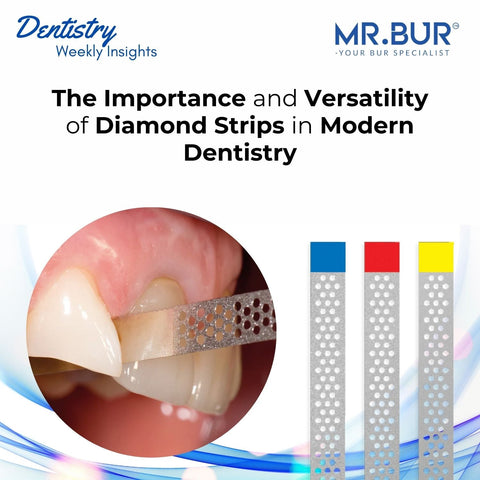In modern dentistry, diamond strips have become indispensable tools for precise enamel reduction and interproximal contouring. Selecting the appropriate type—single-sided or double-sided—is critical to achieving optimal outcomes in specific dental procedures. Each design serves distinct purposes, and understanding their applications can significantly enhance procedural efficiency and patient care.
Understanding Diamond Strips
Diamond strips feature an abrasive surface used to trim and shape enamel in hard-to-reach interproximal areas.
Types of Diamond Strips
- Single-Sided Diamond Strips:
- Abrasive surface on one side.
- Protects adjacent teeth or restorations.
-
Ideal for targeted precision.
- Double-Sided Diamond Strips:
- Abrasive surfaces on both sides.
- Streamlines procedures by simultaneously reducing enamel on two teeth.
- Suitable for larger or generalized interproximal reductions.
When to Use Single-Sided Diamond Strips
Single-sided strips are the preferred choice when precision is required near sensitive or restored surfaces.
1. Interproximal Reduction (IPR) Near Restorations
When working adjacent to restorations such as crowns or veneers, the non-abrasive side ensures that only the natural enamel is reduced without risking damage to the restoration.
-
Recommended Sizes: SS13 (0.13mm), SS10 (0.10mm) or SS08 (0.08mm).
2. Refining Aesthetic Contours
For procedures like post-aligner adjustments, single-sided strips allow precise enamel contouring to achieve symmetry and smooth interproximal transitions.
3. Tight Contacts
In situations where teeth are crowded, single-sided strips offer the control necessary to navigate and shape without compromising neighboring teeth.
-
Clinical Tip: Use slow, controlled motions to ensure uniform reduction.
When to Use Double-Sided Diamond Strips
Double-sided strips are efficient for cases that require enamel reduction on both sides of a contact point.
1. IPR for Clear Aligners
Double-sided strips expedite the process by simultaneously addressing both interproximal surfaces, creating the space needed for aligner tracking and movement.
-
Recommended Sizes: SD10 (0.10mm) for small reduction, SD12 (0.12mm) for moderate reductions or SD16 (0.16mm) for larger adjustments.
2. Crowding Management
Double-sided strips are effective for reducing enamel in cases of generalized crowding, particularly when multiple teeth require interproximal adjustments.
3. Smoothing Post-Bur IPR
After using IPR burs, double-sided strips can refine the surfaces, ensuring smooth contacts and minimizing plaque accumulation.
Using Diamond Strips During Crown and Bridge Procedures (Prosthodontics)
Preparing Interproximal Contacts: Single-sided diamond strips are perfect for refining interproximal areas without affecting adjacent teeth. This ensures a snug fit for crowns and bridges, minimizing alignment issues.
Adjusting After Cementation: Double-sided diamond strips allow precise adjustments to both contacting surfaces post-cementation, enhancing comfort and reducing stress on adjacent teeth.
Polishing Before Impressions: Diamond strips smooth interproximal areas, ensuring accurate impressions for lab fabrication and eliminating irregularities for seamless crown margins.
Advantages of Using Mr. Bur’s Diamond Strips
- Wide Range of Sizes: Single-sided strips (0.08mm–0.13mm) and double-sided strips (0.10mm–0.16mm) accommodate various clinical needs.
- Serrated Edge Design: Enhances cutting efficiency and reduces operator fatigue.
- Precision Control: Ensures accurate enamel reduction without excessive damage.
- Versatility: Suitable for orthodontics, restorative adjustments, and post-IPR finishing.
Best Practices for Diamond Strip Selection
- Assess Procedure Goals: Determine whether precision or efficiency is the priority.
- Match Strip Type to Anatomy: Use single-sided strips for confined areas and double-sided strips for broader reductions.
- Consider Patient Comfort: Employ smooth motions and avoid excessive force to enhance patient experience.
Traditional Strip vs. Diamond Strip
- Material:
- Traditional Strips: Typically made of stainless steel or polymer, used for general interproximal tasks.
- Diamond Strips: Coated with diamond grit, offering superior cutting efficiency and precision.
- Functionality:
- Traditional Strips: Suited for basic polishing or mild reduction tasks.
- Diamond Strips: Designed for precise enamel reduction and finishing, especially in orthodontics and restorative procedures.
- Applications:
- Traditional Strips: Ideal for minor adjustments in less demanding cases.
- Diamond Strips: Used in more intricate procedures requiring control, such as IPR or crown finishing.
Choosing between single-sided and double-sided diamond strips is crucial for achieving precise and efficient outcomes in various dental procedures. With Mr. Bur Diamond Strips, dentists can deliver exceptional results, ensuring patient satisfaction and clinical success. Integrating these tools into your practice will elevate your approach to enamel reduction and interproximal management.
You Might Also Like:
Diamond Burs, Carbide Burs, Surgical & Lab Use Burs, Endodontic burs, IPR Kit, Crown Cutting Kit, Gingivectomy Kit, Root Planning Kit, Orthodontic Kit, Composite Polishers, High Speed Burs, Low Speed Burs






